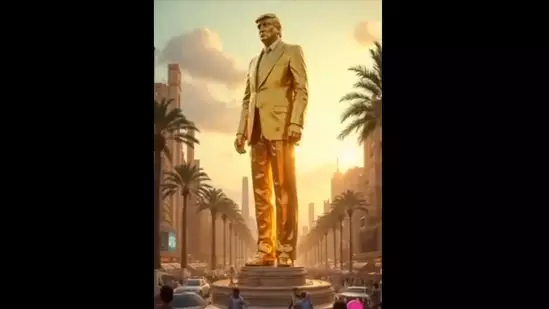Recently, former President Donald Trump shared an AI-generated video on his Truth Social platform that has drawn significant attention due to its provocative content. The video begins with a bleak depiction of Gaza, gradually shifting to an imagined future where the area is transformed into a picturesque paradise filled with beaches, contemporary skyscrapers, and representations of Trump himself. This juxtaposition starkly emphasizes the themes of hope versus despair. In the narrative presented, the phrase “Gaza 2025… What’s Next?” acts as a rhetorical question, inviting speculation about the actual feasibility of Trump’s plans.
Accompanying the imagery is a catchy jingle with lyrics that illustrates an aspirational vision for Gaza, suggesting that under Trump’s leadership, the region would experience a renaissance of economic opportunities and social harmony. However, such a portrayal raises essential questions about the underlying realities of the situation in Gaza. The video and its simplistic narrative gloss over the complexities of decades-long conflicts, humanitarian crises, and the cultural significance Gaza holds for its inhabitants.
Trump’s public statements regarding his intention to “take over” the Gaza Strip have garnered mixed reactions. At a press conference earlier this month, he expressed that the U.S. would assume responsibility for the region’s redevelopment. This claim not only sparks debate about the practicality of such an intervention but also raises ethical and legal considerations surrounding sovereignty and governance.
By proposing a hands-on U.S. approach to dismantling existing structures and addressing the remnants of conflict, Trump’s vision implies a complete overhaul of Gaza’s socio-political landscape. Nonetheless, his words have been met with skepticism. Critics, including Wassel Abu Yousuf from the Palestine Liberation Organization, have labeled the AI video as trivializing the very real struggles of the Palestinian people. Such a response underscores the potential for disconnect between grand visions and the lived experiences of individuals on the ground.
The ramifications of Trump’s plans extend beyond Gaza and have stirred concerns among neighboring Arab nations. Leaders from countries including Egypt, Jordan, and Qatar convened to discuss strategies that prioritize Palestinian welfare amidst fears of further displacement. This diplomatic response indicates a significant regional apprehension regarding U.S. hegemony in Middle Eastern affairs, echoing sentiments that the historical and cultural significance of Palestinian territory cannot be dismissed casually.
Trump’s subsequent interviews suggest a firm belief in the efficacy of his plan, as he positions himself as the author of a path forward. However, this confidence clashes with the unease expressed by local leaders in Gaza and surrounding areas, who reject the idea that such a transformation could occur without proper recognition of historical injustices and ongoing struggles against occupation.
The AI-generated video serves as an intriguing case study in how digital media can influence public perception. On one hand, it attempts to reframe Gaza from a conflict zone to a canvas for luxury and investment. On the other hand, it simplifies critical issues into a bite-sized, digestible format that may obscure the underlying complexities. The use of AI in this context raises further questions about authenticity and the ethics of representation in digital media.
As Trump’s plans continue to stir debate both domestically and internationally, it is crucial for discourse around such topics to encompass a range of perspectives. The voices of those who reside within Gaza should be amplified, as they are the true experts on the consequences of policy decisions made far from their realities.
In light of all these discussions, Trump’s AI video represents more than just a promotional tool; it reflects a broader issue of how leadership and ambition can be misconstrued in the context of sensitive geopolitical landscapes. As conversations about Gaza evolve, it becomes essential to scrutinize not only the plans presented but also to engage in meaningful dialogue that respects the realities faced by its people. The future of Gaza hinges not on digital fantasies but on the commitment to understanding and addressing the deep-rooted complexities that have long defined the region’s plight.
